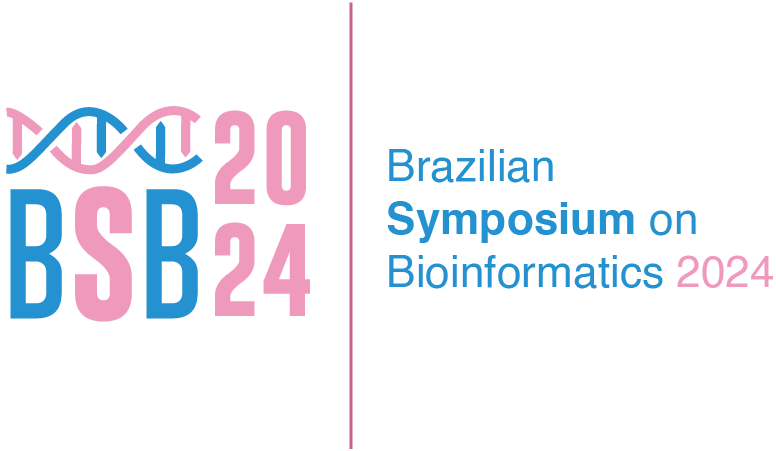Accepted works
Full papers
- A Comparative Study of CNN for Prediction of Human Cancer Types Integrating Protein-Protein Interaction Networks and Omics Data
- A computational pipeline for species- and strain-level classification of metagenomic sequences
- AutoBioLearn: An Automated Data Science Framework for eXplainable Analyses (XAI) of Clinical Datasets
- COCaDA – Large-Scale Protein Interatomic Contact Cutoff Optimization by Ca Distance Matrices
- Comparison of computational fusion detection methods for short-read RNA-seq data
- Evaluating the Generalization of Neural Network-Based Pan-Cancer Classification Models for Cohort-Specific Predictions
- Genomic and phylogenetic analysis of plant growth-promoting bacteria
- Graph Attention Neural Networks Improving Molecular Docking Rank with Protein-Ligand Contact Maps
- Heuristics based on Adjacency Graph Packing for DCJ Distance Considering Intergenic Regions
- Modeling cell signaling pathways through universal differential equations and joint inference of first-principle parameters and neural network weights
- Optimized Neural Networks for Breast Cancer Classification Using Gene Expression Data
- Predicting Mutation-Driven Changes in the SARS-CoV-2 Spike Protein Using Structural Signatures and Neural Networks
- Scaling Up ESM2 Architectures for Long Protein Sequences Analysis: Long and Quantized Approaches
- Squares in Cycles: Prediction of G-Quadruplexes in Circular RNA Secondary Stuctures
- Teaching bioinformatics programming in high school: a case report
- Towards a simpler computational semantics for molecular biology
- Towards a Surrogate-assisted PALLAS algorithm for Gene Regulatory Network Inference
- Tuning a predictive DNA replication programming computational model for Trypanosomatids
- Unraveling Evolutionary Paths: Genomic Divergence and Geographic Secrets of Cylindrospermopsis and Sphaerospermopsis
- Using graph-based structural signatures and machine learning algorithms for molecular docking assessment of histone deacetylases and small ligands
Short papers
- A strategy for refining the calculation of contacts in protein-RNA complexes
- In silico study of the impact of the PRKAG2-H401Q mutation on AMPK affinity for AMP and ATP
Posters
P01 – A bioinformatics approach to define host-element boundaries using Microviridae phages and casposons as study models
P02 – A Curated Dataset for Machine Learning Training to Predict Novel Peptide Inhibitors of Voltage-Gated Sodium Channels in Drosophila suzukii (Matsumura, 1931)
P03 – A genomic approach to the selection of growth-promoting bacteria in maize using reverse ecology
P04 – A graphical bioinformatics tool for delineating viral taxonomic levels
P05 – A Tm-value prediction system and molecular dynamics analysis of AmNA-containing gapmer antisense oligonucleotides
P06 – Analysis of rbd-spike interactions of sars-cov-2 omicron variants with ace2 through molecular dynamics
P07 – Antimicrobial Resistance Genes in Oligotrophic Ecosystems: An Evolutionary Insight from Microbialites and Microbial Mats of Cuatro Ciénegas
P08 – Application of Machine Learning Algorithms for Identification of Viruses in Dark Matter from Next-Generation Sequencing
P09 – Beyond mutations: Human Cytomegalovirus as a driver of heterogeneity in Glioblastoma
P10 – Bioinformatics analysis revealed that NOTCH1 expression in Glioblastoma Multiforme patients and Glioma Stem Cells is associated with impaired cellular OXPHOS and low immune infiltration
P11 – Characterization of Psychiatric Disorders Cataloged in the DSM-5 Through a Network Approach
P12 – Classification of HIV genomes through graph comparison and analysis
P13 – ClusterONE Web: a web tool for detecting and visualizing overlapping protein complexes in protein-protein interaction networks
P14 – Comparative Analysis of Supervised Classifiers in Predicting COVID-19 Severity Using Data from 239 Exomes
P15 – Comparative Genomic Analyses Highlight the Crucial Role of Mobile Genetic Elements in Paenibacillus strains
P16 – Comparative Genomic Analyses reveal key characteristics for the Biocontrol and the Promotion of Plant Growth in Paenibacillus Strains
P17 – De novo transcriptome assembly and annotation for gene discovery in Euterpe edulis
P18 – Development of a web system responsible for automating the process of validating three-dimensional proteins
P19 – Discovery of Conditionally Independent Networks Among Gene Expressions in Breast Cancer Using Fast StepGraph
P20 – EEG-Based Schizophrenia Classification Using Vision Transformers and Microstate Analysis
P21 – Enhancing Enzyme Generation with Fine-Tuned Conditional Transformers
P22 – Evaluation Of Machine Learning Models In Identifying Neurological Complications Of Covid-19: An Integrated And Comparative Analysis
P23 – Exploring Genetic Determinants of Post-COVID-19 Dyspnea: An Exome Sequencing Approach
P24 – Exploring hybrid dynamic modeling of ordinary differential equations and data-driven models: From validation to expansion assisted by high-resolution mass spectrometry
P25 – Gene Expression Patterns and Their Impact on Muscle pH in Four Swine Genetic Groups
P26 – Genetic study of patients with persistent neurocognitive sequelae after COVID-19
P27 – Genome mining unveils the Algibacter genus as a treasure trove of biologically-active compounds
P28 – Genomic insights into the association between carbohydrate transporters and antimicrobial resistance in Staphylococcus aureus
P29 – Group I introns in the mitochondrial genomes of Trichoderma spp.
P30 – Harnessing Integrated Informatics and Molecular Simulation to Predict Antibody Epitopes on Viral Envelope Glycoproteins
P31 – Homology-based quantification of the fibrosis in the CT image: A proof of concept for CT image feature-assisted gene expression prediction
P32 – Identification of Genetic Alterations in Patients Who Developed Physical Fatigue as a Long COVID Condition
P33 – In silico validation of Linear B-Cell epitopes using Machine Learning: A proposed approach with organisms of genus Trypanosoma
P34 – Investigation of UDE-based approaches for cell cycle modeling
P35 – Metabarcoding reveal Fusarium decemcellulare as the potential causal agent of the emergent disease in Coffea canephora
P36 – Metagenomics and Bioinformatic tools in Agricultural Microbiome
P37 – Molecules of the Amazon: Integration and Centralization of Data on the Amazon Flora and its Biomolecules
P38 – Multi-omics systems biology approach identifies novel signature genes for neuropsychiatric disorders
P39 – Network Pharmacology and UHPLC-ESI-Q-TOF-MS/MS Approaches to Explore Active Compounds and Mechanisms of Acerola Seed Hydroethanolic Extract in Obesity Treatment
P40 – Non coding variants near the NOTCH1 gene are associated with frailty criteria in Brazilians older adults
P41 – Nuclear Segmentation of Oncology Microscopy Images through Convolutional Neural Networks: A Comparative Analysis
P42 – Predicting aggregation region in proteins with machine learning based on tertiary structure: web platform
P43 – Predicting side effects of drug combinations in realistic experimental settings
P44 – Predictive Modeling Of Post-covid-19 Hair Loss: Insights From Machine Learning And Logistic Regression
P45 – Sialic Acid Enzymes Database
P46 – SP crime: A Python package for merging São Paulo criminal and medical data
P47 – The potential role of the JAK/STAT pathways in the progression of depressive and anxiety disorders in Long COVID
P48 – The Role of Indel Variants in COVID-19: Unveiling Frequency Patterns and Potential Clinical Significance
P49 – The role of polyploid giant cells in cancer progression and their potential as therapeutic targets: a bioinformatic overview
P50 – Topology-based pan-cancer analysis of DLK1-DIO3-derived microRNA roles
P51 – Transcriptomic analysis of Crassostrea gigas oysters exposed to tamoxifen demonstrates alterations in cancer-associated metabolic pathways
P52 – Transcriptomic analysis of the aged female omentum. Insights on metastatic invasion in a mouse model of ovarian cancer
P53 – Transcriptomic Analysis Reveals a Novel MicroRNA in Porcine Fetuses from Gilds Supplemented with L-Arginine
P54 – Tumor-Regeneration Interplay: Systems Biology and New Models in Comparative Study with Therapeutic Insights
P55 – Unlocking The Anti-aging Potential: In silico Analysis of Astaxanthin, Curcumin, Quercetin, and Resveratrol in Modulating Skin Aging Pathways
P56 – Verdict: An Interactive Web Tool for Exploring Disease Modules and Drug Targets within the Human Interactome
P57 – Large scale analysis of sialic acid incorporation mechanisms of microorganisms from intestinal microbiota
P58 – Improvement of the assembly and Annotation of the Trypanosoma cruzi Genome Using Hi-C Data











